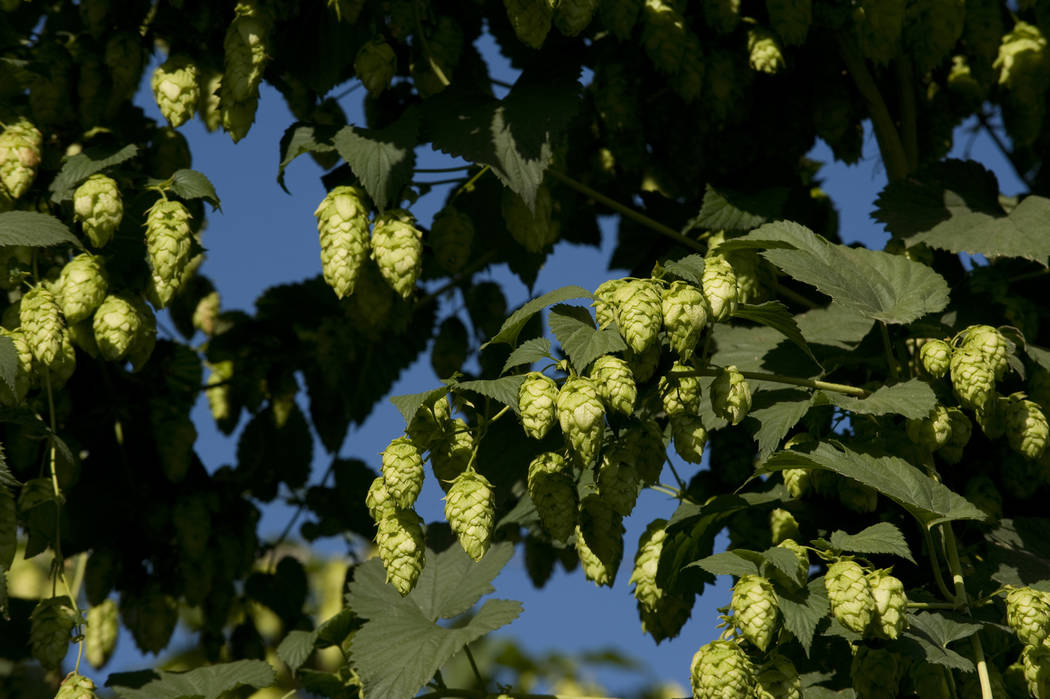
Red Crown Rot of Hop in Oregon Caused by Phomopsis Tuberivora
March 19, 2013
David H. Gent and George Mueller-Warrant, USDA-ARS, Forage Seed and Cereal Research Unit, Corvallis, OR 97331;
Joanna L. Woods, Department of Crop and Soil Science, Oregon State University, Corvallis, OR 97331; Melodie L. Putnam and Megan C. Twomey, Department of Botany and Plant Pathology, Oregon State University, Corvallis, OR 97331
Corresponding author: David H. Gent. [email protected]
Gent, D. H., Mueller-Warrant, G., Woods, J. L., Putnam, M. L., and Twomey, M. C. 2013. Red crown rot of hop in Oregon caused by Phomopsis tuberivora. Online. Plant Health Progress doi:10.1094/PHP-2013-0624-01-BR.
During July 2007, a hop grower in Marion County, OR, reported weak growth and death of plants of cv. Fuggle. The grower noted that symptoms appeared several years prior and had become increasingly severe. The affected yard had patches of plants with underdeveloped lateral branches, uneven and weak bines, chlorotic leaves, and in severe cases plant death (Figs. 1 and 2). The pith of affected roots was reddish-brown in color, dry, and friable. The margin between diseased and healthy tissue was well defined, although in severe cases crowns were entirely consumed by dry rot. The disease symptoms were suggestive of red crown rot, a disease described on hop in Australia and attributed to a Phacidiopycnis sp. (2,3).
Plants in the affected yard were inspected and rated as "healthy" if the plant had reached the top of the trellis and produced lateral branches, "dead" if no foliage was present, and "weak" otherwise. Of 13,289 plants in the yard, 1981 (14.9%) were weak and 237 (1.8%) were dead (Fig. 2). Spatial analysis (1) indicated significant aggregation of weak plants in 75% of rows running either north-south or east-west; dead plants were aggregated in 44% of rows running north-south and 47% of rows running east-west. This suggested disease spread in both directions, and was not preferentially in the direction of mechanical pruning (north-south), as suggested in Australia (2). Soil samples collected on a 0.125 ha grid throughout the yard indicated a positive association between pH, soil nitrogen content, and occurrence of affected plants.
Rhizomes were collected from symptomatic plants, and three isolates of a suspected Phomopsis species were recovered from root pieces and purified through subculturing of hyphal tips. Cultures of the fungus were provided to the USDA Agricultural Research Service Systematic Mycology and Microbiology Laboratory and identified as Phomopsis tuberivora H.T. Güssow & W.R. Foster 1932 [currently synonymous with Phacidiopycnis tuberivora (Güssow & W.R. Foster) B. Sutton 1980] based on morphological characters. Amplification and bidirectional sequencing of the ITS region (4) from the three isolates yielded sequences 99% similar to Phomopsis tuberivora (506 of 507 nucleotide match to GenBank Accession JF957785.2).
Greenhouse inoculations were conducted to fulfill Koch’s postulates. The crown of eight 4-week old hop plants of cv. Agate were pierced approximately 1 cm below the soil surface with a PDA-coated toothpick colonized with Phomopsis tuberivora and then covered with soil. Inoculations were conducted (individually) with each of the three isolates isolates. Six control plants were similarly inoculated with PDA-coated toothpicks. Two months later, plants inoculated with the fungus were partially defoliated and the roots had developed characteristic discoloration and rot of pith tissue, averaging 101 mm in length. Discoloration in controls was limited to the wound site created by the toothpick (Fig. 3). Ten isolations were made from the crown of each inoculated plant; Phomopsis tuberivora was recovered from 60% of the crown pieces assayed, but was not recovered from control plants.
This is the first report of red crown rot on hop in Oregon. Since the initial discovery, the disease has been diagnosed on two other hop farms in Oregon, but appears damaging only in certain cases. In Australia, planting of high quality rootstock, avoiding crown injury, modifying harvest practices, and fumigating have been successful in managing the disease (3). In the case reported here, the grower replanted hops in portions of the affected yard with and without fumigation with a mixture of 1,3-dichloropropene and chloropicrin (197 liters/ha Piclor 60EC; Trical Inc., Hollister, CA) (Fig. 4). Plants established successfully only in fumigated areas. Further investigation of management practices and the linkage between soil pH, nitrogen content, and other edaphic conditions favoring red crown rot are warranted since the disease appears economically important in some yards.
Literature Cited
1. Madden, L. V., Louie, R., Abt, J. J., and Knoke, J. K. 1982. Evaluation of tests for randomness of infected plants. Phytopathology 72:195-198.
2. McGee, P. A. 1997. Epidemiology of hop red rot and strategies for control. PhD diss. Royal Melbourne Institute of Technology, Melbourne, Australia.
3. McGee, P., Lawrie, A., and Porter, I. 2009. Red crown rot. Pages 31-32 in: Compendium of Hop Diseases and Pests. W. F. Mahaffee, S. J. Pethybridge, and D. H. Gent, eds. The American Phytopathological Society, St. Paul, MN.
4. White, T. J., Bruns, T., Lee, S., and Taylor, J., 1990. Amplification and direct sequencing of fungal ribosomal RNA genes for phylogenetics. Pages 29-50 in: PCR protocols. A Guide to Methods and Applications. M. A. Innis, D. H. Gelfand , J. J. Sninsky, and T. J. White , eds. Academic Press, San Diego, CA.
Other stories in:
Back
Liberty Building, 32 N 3rd St - Suite 408 \ Yakima, WA 98901 Mail to: P.O. Box 2885 \ Yakima, WA 98907 1.509.453.4749
